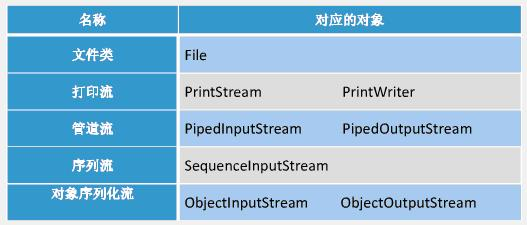IO流的三种分类方式
1.按流的方向分为:输入流和输出流
2.按流的数据单位不同分为:字节流和字符流
3.按流的功能不同分为:节点流和处理流
(节点流表示的是直接操作节点(例如文件,键盘)的流,例如FileInputStream.
处理流(过滤流)表示的是对节点流进行了操作(加工)的类,例如InputStreamReader)
IO流的四大抽象类
字符流:Reader(读) Writer(写)
字节流:InputStream(读数据) OutputStream(写数据)

IO流对象继承关系

其它常用与流有关的对象

节点流类型
IO体系,所具备的基本功能就有两个:读和写
1,字节流
InputStream(读),OutputStream(写)
2,字符流
Reader(读),Writer(写)
结论:只要是处理纯文本数据,就要优先考虑使用字符流,除此之外都用字节流。
InputStream的基本方法
int read() throws IOException 读取一个字节以整数形式返回,如果返回-1已到输入流的末尾
void close() throws IOException 关闭流释放内存资源
long skip(long n) throws IOException 跳过n个字节不读
OutputStream的基本方法
void write(int b) throws IOException 向输出流写入一个字节数据
void flush() throws IOException 将输出流中缓冲的数据全部写出到目的地
Reader的基本方法
int read() throws IOException 读取一个字符以整数形式返回,如果返回-1已到输入流的末尾
Writer的基本方法
void write(int c) throws IOException 向输出流写入一个字符数据
void write(String str) throws IOException将一个字符串中的字符写入到输出流
void write(String str,int offset,int length)
将一个字符串从offset开始的length个字符写入到输出流
void flush() throws IOException
将输出流中缓冲的数据全部写出到目的地
缓冲流:缓冲流要套接在相应的节点流之上,提高了读写的效率。
此处理流的构造方法都得传相对应的基类类型
BufferedReader:提供了readLine方法用于高校读取一行字符串
BufferedWriter:提供了newLine用于写入一个行分隔符也就是换行
BufferedInputStream 没多大用处
BufferedOutputStream 没多大用处
转换流:主要作用将字节流转换成字符流。用处较大!
转换流在构造时可以指定其编码集合
InputStreamReader需要和InputStream套接
OutputStreamWriter需要和OutputStream套接
例:OutputStreamWriter osw = new OutputStreamWriter (new FileOutputStream(文件路径);
方法例:osw.getEncoding(); 获得流的编码方式
数据流与字节数组流
数据流主要为实现可以存取Java原始数据类型如long,boolean
数据流是字节流
DataInputStream需要和InputStream套接
DataOutputStream需要和OutputStream套接
DataInputStream方法:readBoolean() readInt()…
readUTF():网络传输常用方法 读一个Unicode字符串
DataOutputStream方法与DataInputStream基本对应为写的方法
//此构造函数等于已可以往一个字节数组里输入内容
ByteArrayOutputStream baos = new ByteArrayOutputStream ();
//此方法为获取一个字节数组方法返回字节数组
baos.toByteArray();
//此方法获取字节数组占了多少字节
new ByteArrayInputStream(一个字节数组)。available()
ByteArrayOutputStream baos = new ByteArrayOutputStream();
DataOutputStream dos = new DataOutputStream(baos);
try
{
dos.writeDouble(Math.random());
dos.writeBoolean(true);
ByteArrayInputStream bais = new ByteArrayInputStream(baos.toByteArray());
System.out.println(bais.available());
DataInputStream dis = new DataInputStream(bais);
System.out.println(dis.readDouble());
System.out.println(dis.readBoolean());
dos.close();
dis.close();
}
catch (IOException e)
{
e.printStackTrace();
}